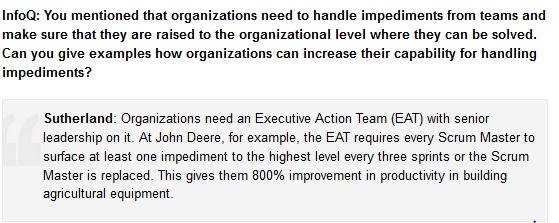A colleague of mine who works as an Agile Coach for Ericsson told me she has seen adoption/struggle/rejection repeat in regular three year cycles. She’s on her third or fourth cycle now.
We appear to be following true to that pattern. Three years ago senior executives met at a meeting where the good, the bad and the ugly of attempting to adopt any sort of real agile approach was laid out for them so they could make what I term an “informed consent”. At the end of that meeting I asked them to decide, and if they said no, that was OK, but if they said yes, I expected them to take the steps necessary to help alter the forces in the organization that are at the root of many impediments. Three years ago they said yes, and since then we have helped hundreds of teams and dozens of products, but most importantly there are many more people who see with clear eyes and can reason in ways we didn’t use to. One of the interesting side-effects of a journey like this is a significant increase in better middle managers, regardless of what you think of agility (see Management 3.0).
The group of coaches we have built up has effectively been disbanded. I look forward to the day when someone decides “we need to get our head around this agile stuff” and we try again.
I’m optimistic this resurrection will occur. The logic behind it is very compelling, and it really is a competitive advantage, one that our competitors are working mighty to master to use against us. The more we struggle with the ever increasing rate of regulatory changes and requirements changes from our customers, the more we need organizational agility.
We’ve left behind loads of artifacts for any subsequent organization archeologist who may dig through our remnants. I recognize lots of people still depend on <internal wiki>, so that will remain intact indefinitely. Perhaps the leaders of the next attempt will be able to leverage some of these materials.
I’m quite proud of the extended team of coaches & colleagues who worked with us across all the lines of business. They are a generous and knowledgeable bunch, often working against their own self-interest for the greater good, and they are the reason we have gotten as far as we have.
Robin Leopold (HR) pointed out that over half of our workforce are millennials, and that number is growing (“The M-Word”). I hadn’t made the connection before, but much of what this age bloc is seeking in the way of meaningful work, opportunities for growth and respect are also precisely the constructs we use to build agile teams. Other articles 1, 2, 3 cite retention as a systemic problem with millennials. Why does this matter? A normal, healthy age distribution across any company is uniform or perhaps even slightly pyramid, so there are always a pool of people being groomed to step in and replace people above them, and stay long enough to sustain the company until another generation passes and they are replaced. If we suffer an extended period of retention, we end up with a bimodal distribution – a dumbell – in which the old guard camps at the top, there is a chasm of age with a dearth of experience, and a cluster of largely inexperienced people in the other lobe. As time and retirements take their toll, the unwritten working knowledge of how things really work will be lost, and younger people may be forced to step into roles for which they are ill prepared. While that may sound theoretical, I’ve seen it happen, and it is preventable. It should be no surprise if I suggest that this ticking generational bomb can be at least partially mitigated by the structures we use for building agile, nimble, responsive products.
If you like to read the original research on millennials, here are some studies Robin has shared:
- Female Millenials in FS.PDF
- gx-millenial-survey-2016-exec-summary.pdf
- millennials-at-work.pdf
- Workforce Mindset Study 2015 .pdf
Footnotes
- “Millennial Employees Confound Big Banks“, WSJ, April 8, 2016
- “Goldman Sachs Sweetens Deal for Young Bankers“, WSJ, November 5, 2015
- “Wall Street’s Playbook for Managing Millennials“, WSJ, April 8, 2016




